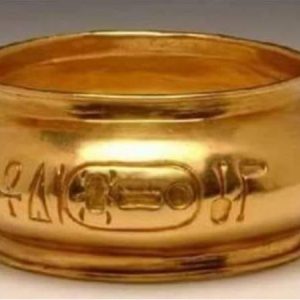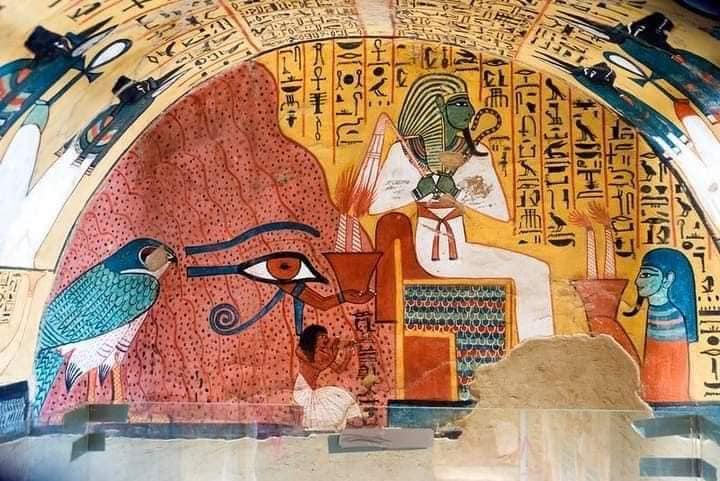The history of the adherence of “gold” to worship. Why did the Pharaohs sanctify it, and the Christians used it in the churches?
Gold has a value in antiquity.” A phrase that might shock you,
In the past centuries, gold was treated like any metal extracted from the ground. As for a reason for its low profitable value in ancient civilizations, it is due to the abundance of the shiny metal like most minerals, but after the children of the world’s civilizations were kidnapped with its lustre and elegance, its place on the throne of minerals became a place that the mineral deserves legendary.
And if you ask the experts, “When was the initial discovery of gold?” you will not find a more accurate current answer than that of a substance that was found during the Stone or Bronze Age, the era of the emergence of alloys, metallurgy and the beginning of mixing between minerals. It is likely that the first appearance of the substance near rivers in Asia Minor.
The beginnings of the appearance of the shiny substance
Going back to the first civilizations and cultures, in ancient Egypt, Africa, Rome and Greece, you find gold as a substance that sticks to the crafts of their artistic hands, specifically Egypt. Even King Tushratta, Emperor of the Mitanni Kingdom of the Hurrians in northern Syria (his daughter married the Pharaonic King Amenhotep III and then Akhenaten), described gold in Egypt, in 2600 BC, with “material available to the extent that exceeds litter rates,” according to the “Eternal Egypt” website.
The best evidence of Egypt’s richness in gold, according to the international “artsy” website, which specializes in discovered and artistic artefacts, is the density of mining sites for gold extraction, which was revealed by the Turin archaeological map – currently in the Italian Museum of Turin – and dates back to the era of King Ramses II, such as the pottery mine and the series of gold mines between Luxor, the Red Sea and about a thousand other mines, so here is the history of the mineral between civilizations and religions, and the motive behind the rise in its price value without the rest of the minerals over the years.
Pharaonic civilization and gold magnification
At the forefront of civilizations, which gave gold its current attractiveness, is the Pharaonic civilization, and was behind the attachment of the ancient Egyptian civilization to metal, the availability of gold in Egypt, so the Egyptians entered it with ancient miniature statues and used gold in the inscriptions on the walls, and the gold coins are still so far settled in the tombs, which have not yet been discovered It accompanies the mummified bodies, and between the Egyptian and international museums.
The pharaohs focused on red gold, which is electrum alloys, during which gold is mixed with 20% of silver. These people used it in the manufacture of statues and artistic and gold works. They also stayed completely away from “gold refining” because it did not need further purification; the ancient Egyptians began to attach to gold from here. After being used in statues, he quickly moved to the arts of making jewellery, decorative tools, and clothing for men and women.
The site mentions that specialists in the manufacture of gold coins at the Pharaohs began to launch their creativity with shiny pieces in the pre-dynastic period (4th millennium BC), even before they reached the writing language. Over time, gold became part of their worship, which raised its value, and became its colour. Red is a symbol of the sun, meaning the god Ra, and the statue of Ra was made of gold.
From here, there were many forms of gold industries, and the covers for the upper coffins of kings and nobles were made of the material, and each coffin was engraved and inlaid with precious stones. As for the material of the coffin industry, it varies between wood or stone, and senior politicians using gold or silver to reflect the blessings of the god Ra on their bodies and immortal souls, according to their beliefs.
The “Ancients” did not neglect to cover the face of the deceased with funeral masks of gold, which are covers for the face wrapped in linen, and the manufacture of the mask and its materials differed based on the stature of the owner of the face and his position in the state. The use of gold in masks was limited to the wealthy and the upper class. These masks began to be used before the era of families.
One of the most prominent examples of golden masks is the mask of the pharaonic king of the 18th dynasty, Tutankhamun, and the weight of his mask, which covers his face inside the historical sarcophagus, is about 11,000 kilograms of pure gold.
The pharaohs continued to use gold as a means of expressing their attachment to their gods and kings. Still, the idea of using gold did not seep into daily life, whether in the form of coins or a metallic material circulating among craftsmen, but rather as a sign of “spiritual strength.”
Despite the intensity of the Pharaonic gold monuments, between political and personal belongings in the tombs, the rates of the ancients’ use of gold did not top the list of “civilizations that use the most gold.” The volume of their use is estimated at a ton of gold annually, compared to the Roman civilization’s use of 1400 tons per year, which shows that the civilization The Roman was fond of gold, to greater degrees than the Pharaohs.
The Inca Civilization and the “Lost Gold”
The ancient empire built by the American Indian peoples in South America knew gold. Its history was associated with gold industries so that a legend sticks to the people and bears the name “The Lost Gold of the Incas.”
That legend, surrounded by tales of death and mystery, where the Inca people claim the disappearance of metallic material and gold works in the depths of the “Lianganates” mountain range, far from the eyes of the Spanish conquistadors when they tried to steal their gold, at a time when peoples realized the importance of gold and its profit value.
But some artefacts remained from the remnants of the ancient civilization to express the Inca culture and the extent of their attachment to gold in their worship. A mask for a human face was found, and from the upper parts came a wrinkled sunray .
.
The mask expresses the Inca sun god “Inti”, which is currently on display in the National Museum in Quito’s Ecuadorean capital. Thus, the Inca peoples are among the oldest civilizations interested in gold and attached it to their worship, which means decoration and beauty.
Civilization was interested in building temples to worship their sun god. Among their most prominent temples covered with gold, the Temple of the Sun “Kurikancha” in Cuzco, the empire’s capital, and includes golden statues of the elements of nature. The Incas were busy making jewellery and masks they wore of metallic material.
Egypt Magic – The history of the adherence of “gold” to worship
July 6, 2021
0 comment


Comment (0)